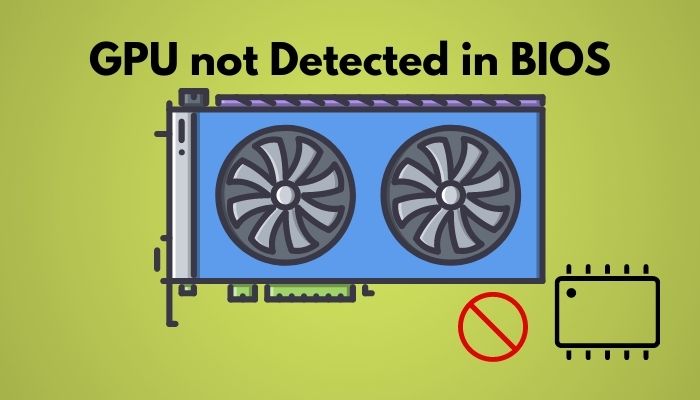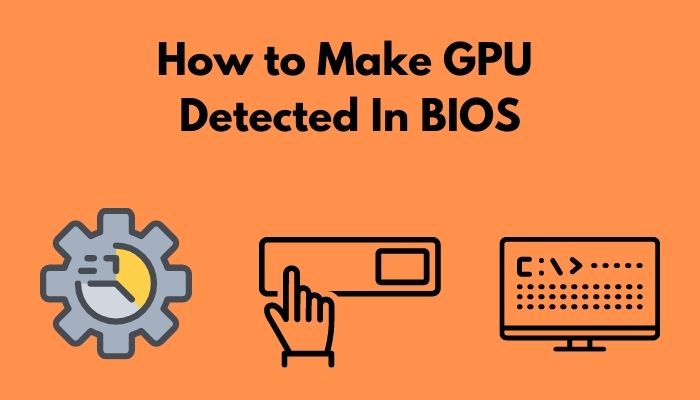Is there anything irritating that your GPU is not showing up in your BIOS? I suppose there is none. I have been there.
As a hardware geek, I have been using different types of GPUs and iGPUs for the last decade and unfortunately, this issue has happened to me more than once. With the vast experience of resolving this matter, I shortlisted some workable yet straightforward solutions for you.

But before I serve you the fixation process, you must know why this issue occurs.
So, Why does GPU not detected in BIOS?
Not sure about the one is behind your problem? Continue reading to find out.
Why isn’t My GPU not Showing Up?
Finding out the reason is halfway to solving the not detecting issue. There are several grounds behind your GPUs disappearance, and you need to find out the exact one which causing you the trouble.
I have arranged a list of possible reasons behind the vanishing of GPU in the boot menu. You are the master at finding out the exact one.
Here are the probable causes of GPU not showing:
- Improper installation: It is the most common cause that creates this issue. GPU slots are not workable if you use them improperly. Check again whether you installed the GPU correctly or not.
- Wrong GPU Driver: installing a GPU with a wrong or outdated driver also triggers the boot menu to hide the drive in order to avoid conflict.
- Outdated BIOS: An outdated BIOS can’t be compatible with modern GPU drivers. It gets confused; therefore, the graphics unit remains undetected.
- Bugged OS: It sounds funny, but believe me, I have faced this problem one time just for the bugged operating system. If you have updated your OS recently, it might be a reason behind your GPU not showing.
These are the possible reasons why your GPU gets undetected. There may be another reason other than these, i.e., failed GPU or faulty motherboard. But don’t worry. These are the worst-case scenario.
Try the fixes regarding the list. I’ll tell you when it’s time to panic.
Follow our guide to fix keyboard not working in BIOS.
How to Make GPU Detected In BIOS
In the previous section, I explained the causes behind GPUs not showing up in BIOS. I’ll clarify how you can get around this issue in this part.
Apply the exact solution if you’ve found which one from the earlier paragraph causes your problem. And if you are not sure about the reason, follow the next methods in an orderly.
These are the most workable solutions I found while solving this matter on my computer. You need to read attentively and work according to the methods. These fixes will also work if your GPU fan is spinning but isn’t detected.
Note: Before fixing anything, make sure your power supply unit can handle your GPU. Make sure it can provide the power your system needs. An insufficient PSU can cause many terrible problems like not detecting GPU.
Here are the fixes for you to apply:
1. Change BIOS Settings
Sometimes, incorrect BIOS settings provoke your GPU from getting discovered. You should change the setting to see if that works for you as your first step.
Here’s how you can change the BIOS settings:
- Press Esc / F2 / F12 / Delete key while turning on your PC to enter the Boot menu.
- Select the BIOS menu by navigating your arrow keys and press Enter.
- Search for PCI / PCIe settings / onboard backup. Here you can see options like IGP > PCI > PCI-E or, PCI-E > PCI > IGP.
- Change the setting to the second one. If the 2nd one is the setting of your BIOS, do not change it.
- Save changes and exit.
Check if the issue’s been resolved or not. If not, then follow the next method.
Check out the easiest way to gateway BIOS updates.
2. Enable Discreet GPU
This is also a very simple trick to resolve the matter. This changes another setting in your BIOS and helps you to show up the GPU.
Here’s the process to apply the settings:
- Turn on your system and press F2 / Delete to boot into BIOS.
- Go to Chipset Configuration with the help of your arrow keys.
- Select GPU Configuration from the menu and look for GPU function.
- Enable the function if it is disabled.
- Save the changes and exit.
This method helps your BIOS to discover a new GPU. If your BIOS has no issue, this trick should resolve the matter. Don’t worry if the problem exists, and I’m determined to help you no matter what. Let’s jump on the following method.
3. Enable GPU Using Command Prompt
You can enable your GPU detection by writing some simple commands on cmd.
Here’s the way to command:
- Type cmd in the windows search bar.
- Right-click on the command prompt and select run as administrator.
- Copy this command bcdedit /set pciexpress forcedisable and paste it to cmd.
- Press enter to execute the mission.
After you get the confirmation of successful operation, restart the PC and check if that resolves the issue.
4. Update BIOS
As I mentioned earlier, an outdated BIOS fails to detect modern hardware. In order to get rid of the issue, you might need to update your BIOS. Don’t know how to do that? Well, I’m here to guide you.
But remember this, Updating BIOS inaccurately can cause serious problems. So, please take every step carefully.
Here’s how you can update BIOS:
- Turn on your Computer.
- Press Windows + R to open run.
- Write msinfo32 in the Run box and press enter.
- Collect the BIOS data from the appeared window.
- Search on the manufacturer’s website if the latest version is available.
- Download the version and install it properly.
- Restart the computer after the installation process ends.
If the detection issue occurred for an outdated BIOS version, this procedure should solve that. If that’s not the case, check the next method.
5. Uninstall OS Update
Imagine playing games or rendering videos with your GPU, and it’s working just fine. Then your PC notify you about a windows update, and like everyone, you install the updates. After that, you get vanished from the system.
If that’s the case, then there’s much possibility that your Operating system is the culprit. You need to uninstall the current OS.
Here’s the process to uninstall the update:
- Search Programs and features in the windows search box. Click on the result to open the window.
- Click on View installed updates from the left panel.
- Locate the recent update by selecting the installation date.
- Select the update and click
- Follow the on-screen instructions to complete the process.
After uninstalling, your PC might need a reboot. Don’t hesitate to do that, and this should solve the bugged OS issue.
These easy methods should work if your GPU doesn’t get recognized by your BIOS. These fixes worked for me, and I believe they’d work for you just fine.
Also, check out our expert’s recommended fastest PCIE 4.0 SSDs.
GPU not Detected in Device Manager
Besides not being detected in BIOS another common issue you might face is your GPU not showing up in the device manager.
This might be caused for various reasons. I’ll explain some easy fixes you can apply to avoid trouble.
Here’s how you can fix not being detected in the device manager:
- Show Hidden devices: Run cmd as an admin. Type the command devmgr_show_nonpresent_devices=1 and hit enter. After that, open the device manager and click on the view tab. Select show hidden devices from the list. This should do the work. Reinstall the driver to complete the action.
- Update GPU driver: Whether your graphics unit gets detected in the DM or not, you need to install the latest driver for your GPU. Go to manufacturer’s website > Select GPU model > Select os version> Download and Install the recent version available. After installation, restart your PC
- Restore BIOS to Default: This issue might be caused for incorrect BIOS settings. To solve that, Enter BIOS by pressing F2 while rebooting. Press F9 to load the factory default settings. Save the changes and exit.
These flawless efforts will solve your GPUs not showing up on the Device manager. All you need to do is follow the methods precisely, as I elaborated.
Check out our separate post on Motherboard Affecting Performance on PC.
Conclusion
I tried to deliver the best obtainable solutions throughout this article based on my own experience with this problem.
I can assure you if you follow them precisely, you will be able to solve the issue on your own, and you won’t have to roam around through the internet regarding this matter.
Feel free to leave a comment if any of the methods seem complicated for you.




